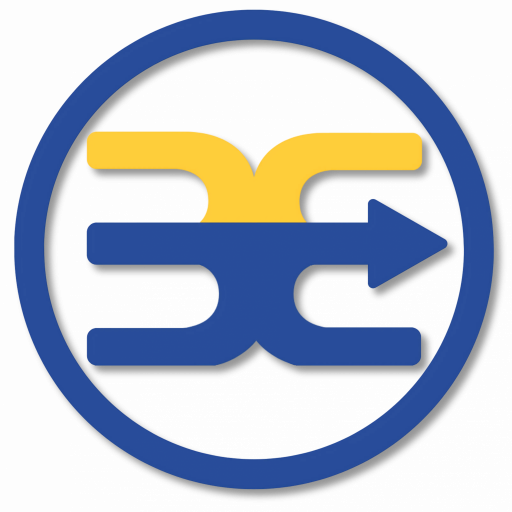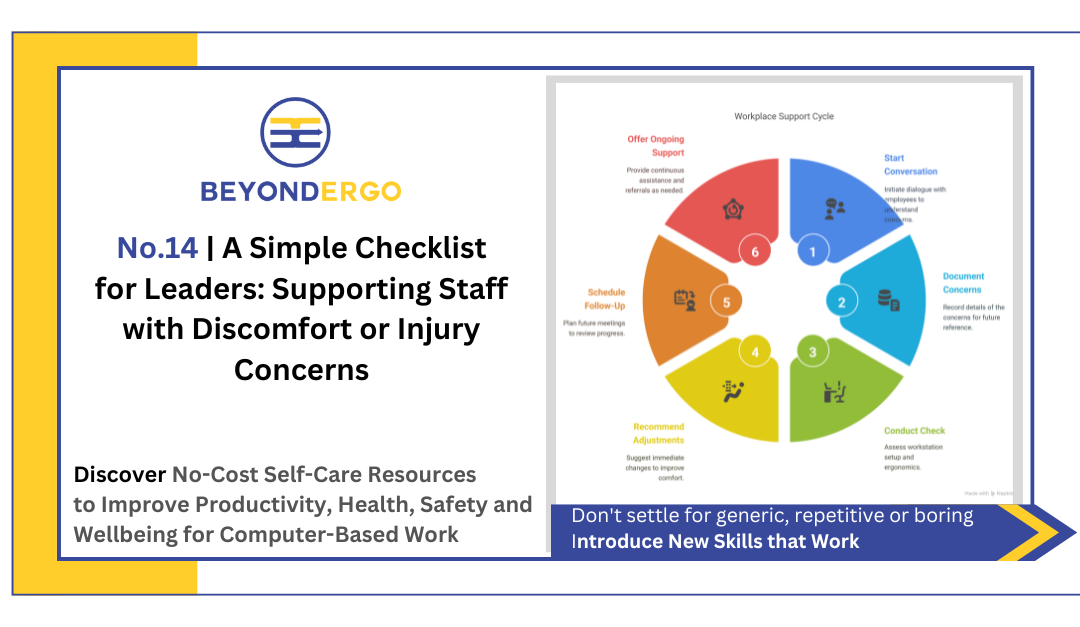Have a team member reported headaches, back pain, or possible overuse injuries from working at a computer?
If you’re unsure what to do next—this guide is for you.
This article offers a practical starting point for leaders to respond confidently and supportively when someone raises a health concern potentially related to computer-intensive work. It’s designed as a suggested checklist, not a formal process—something you can adapt to your own team or organisation’s policies. Most importantly, it helps turn an awkward conversation into a professional leadership moment that can benefit the whole team.
Why It Matters: Benefits of a Clear Response Plan
By using a consistent and supportive response when a team member raises a health concern, you:
- Encourage early intervention—reducing the risk of escalation
- Build trust with all team members, including remote workers
- Strengthen coaching and communication skills
- Reduce absenteeism, presenteeism, and attrition-related costs
- Promote a culture of care and accountability
- Make compliance and documentation easier
- Bridge the gap between WHS policy and real-world daily practices

✔ Suggested Action Checklist
This two-stage checklist gives leaders a framework to manage the first conversation, assess the situation, and determine whether to escalate or continue monitoring.
◆ Stage 1: Start the Conversation
Step 1: Acknowledge & Document the Concern
- Find a quiet time to meet. Listen actively and thank the team member for speaking up.
- Ask permission to take notes, and clarify these won’t go into their personal file unless they request further support (e.g. EAP or formal escalation).
- Ask open, curious questions:
- What are the symptoms? When did they start?
- What’s their workstation setup like?
- Have there been recent workload changes or longer screen time?
- Thank them for bringing the issue to your attention
Your goal is to understand, not diagnose—and to start documenting for early intervention.
Step 2: Conduct a Basic Check
- Look at workstation ergonomics. Are they using their setup correctly?
- Have they had, or do they need, a formal workstation assessment?
- Ask about equipment changes (especially for hybrid workers), lighting, screen glare, breaks, or posture habits.
- Download our holistic ergonomic and work-from-home checklist for a deeper dive into identifying triggers.
Step 3: Recommend Immediate Adjustments
- Encourage regular breaks and postural changes.
-
o Movement is Medicine
- Promote strategies like the 20:8:2 Rule: 20 minutes work → 8 minutes standing → 2 minutes walking.
- Share resources for tension release, posture reset, and to build postural mindfulness.
Step 4: Schedule a Follow-Up
- Talk through and coach initial suggestions to ensure they are applied.
- Agree on a date to check in and check progress.
- Evaluate whether the concern is resolving or needs to be escalated.
- Use this follow-up to reinforce your support and gather any further updates.
◆ Stage 2: Offer Ongoing Support
Step 5: Refer to Appropriate Support
If symptoms persist at follow-up:
- Discuss next steps: ergonomic assessments, GP consultation, EAP, or occupational health referrals.
- With consent, share workstation photos or relevant information with support professionals.
- Consider enrolling the team member in a Beyond Ergo self-care competency training program—VET-style training that builds real-world, practical skills to prevent overuse injuries and support healthy computer use.
Step 6: Continue to Check In
- Encourage continued feedback and reporting.
- Encourage the team member and make your own diary notes to record changes in discomfort, steps taken and costs involved.
-
- These notes will be invaluable if a work injury claim is required.
-
- Look for patterns—are other team members reporting similar issues?
- Share general coaching tips at team meetings to encourage wider adoption of healthy work practices (without singling out anyone).
Coaching Tip for Leaders
Team Approach: When one person raises an issue, use it as an opportunity to coach the entire team without identifying the individual. This removes stigma and may address problems others are experiencing silently.
Engagement Booster: During follow-ups, try this powerful phrase: “I’m giving you this constructive feedback because I have very high expectations, and I know that you can reach them.” The formula of high expectations + demonstrated belief = high performance.
Want a Manager’s Coaching Toolkit?
Would you like this checklist developed into a self-care coaching resource you can use with your team?
Email me | lizk@beyondergo.com.au | Share ideas on improvements and preferred formats. Early intervention is always better than recovery.
Let’s Connect
Auscontact Conference 2025 | I’ll be in Melbourne, April 28–30.
Let’s meet for a coffee and chat—what challenges are you seeing with your team? I’m always happy to offer advice or share insights. Let me know how I can help.
Take charge of your comfort at work—grab your Free Stretch at Your Desk sheet to loosen tight muscles and the Roll–Reset–Relax guide to release neck strain and restore posture. If pain is already affecting you, book a 1:1 consultation for personalised strategies that get you back on track.
💡 Enjoyed this post?
Subscribe to our monthly newsletter for fresh insights and Beyond Ergo updates — straight to your inbox.

